Care for the
Injured
 Unlike most
of our hominid ancestors, apart from Cro-Magnon
Unlike most
of our hominid ancestors, apart from Cro-Magnon  man, Neanderthals
depicted human qualities, because they cared for their wounded and disabled, and
buried their dead. There have been many archaeological discoveries to support
this. A major find was the "Old Man" at La-Chappelle-aux-Saints. This person was
about forty-years-old, equivalent to an octogenarian today, and had suffered
from severe paralysis and arthritis, including a broken jaw and missing teeth.
Apparently, he had been taken care of in order to survive as long as he did.
Someone else had to provide his food, since he could not hunt, feed him and
probably pre-chew his food, and assist him in moving about.
man, Neanderthals
depicted human qualities, because they cared for their wounded and disabled, and
buried their dead. There have been many archaeological discoveries to support
this. A major find was the "Old Man" at La-Chappelle-aux-Saints. This person was
about forty-years-old, equivalent to an octogenarian today, and had suffered
from severe paralysis and arthritis, including a broken jaw and missing teeth.
Apparently, he had been taken care of in order to survive as long as he did.
Someone else had to provide his food, since he could not hunt, feed him and
probably pre-chew his food, and assist him in moving about.
 Another
example of care for the disabled and elderly is the Shanidar I specimen, found
in Shanidar Cave in the Zagros Mountains of Iraq. According to Ralph Solecki,
the archaeologist who headed the Shanidar project, this individual, who lived to
be around the age of forty, was blind in his left eye, suffered from arthritis,
and his atrophied right arm had been amputated. This Neanderthal "could barely
forage and fend
Another
example of care for the disabled and elderly is the Shanidar I specimen, found
in Shanidar Cave in the Zagros Mountains of Iraq. According to Ralph Solecki,
the archaeologist who headed the Shanidar project, this individual, who lived to
be around the age of forty, was blind in his left eye, suffered from arthritis,
and his atrophied right arm had been amputated. This Neanderthal "could barely
forage and fend 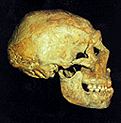 for himself, and we must assume that he was accepted and
supported by his people up to the day he died" (Solecki 1971:196). Otherwise, he
would not have been able to endure for so long the heavy rigors of Neanderthal
life. Although severely disabled, Shanidar I was still able to perform some
daily activities. This is evident in the severe amount of wear upon his front
teeth, which are literally worn down to the root. "It presumable indicates that
in lieu of a right arm, [Shanidar I] used his jaws for grasping, while
manipulating with his good left arm and hand" (Solecki 1971:196).
for himself, and we must assume that he was accepted and
supported by his people up to the day he died" (Solecki 1971:196). Otherwise, he
would not have been able to endure for so long the heavy rigors of Neanderthal
life. Although severely disabled, Shanidar I was still able to perform some
daily activities. This is evident in the severe amount of wear upon his front
teeth, which are literally worn down to the root. "It presumable indicates that
in lieu of a right arm, [Shanidar I] used his jaws for grasping, while
manipulating with his good left arm and hand" (Solecki 1971:196).
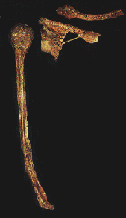 |
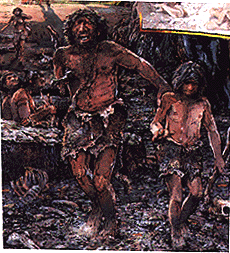 |
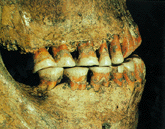 |
Shanidar I's atrophied and
amputated arm |
Shanidar I more than likely had much aid from his
clan. |
Shanidar I's teeth
|
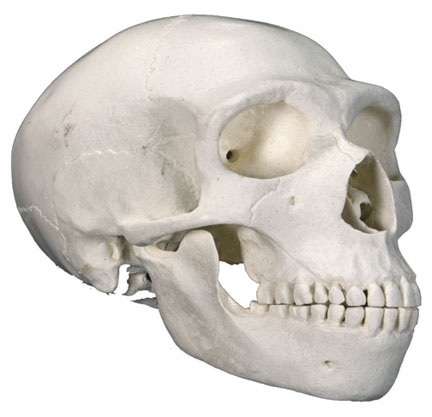 Back to Home page
index
Back to Home page
index
 Unlike most
of our hominid ancestors, apart from Cro-Magnon
Unlike most
of our hominid ancestors, apart from Cro-Magnon  man, Neanderthals
depicted human qualities, because they cared for their wounded and disabled, and
buried their dead. There have been many archaeological discoveries to support
this. A major find was the "Old Man" at La-Chappelle-aux-Saints. This person was
about forty-years-old, equivalent to an octogenarian today, and had suffered
from severe paralysis and arthritis, including a broken jaw and missing teeth.
Apparently, he had been taken care of in order to survive as long as he did.
Someone else had to provide his food, since he could not hunt, feed him and
probably pre-chew his food, and assist him in moving about.
man, Neanderthals
depicted human qualities, because they cared for their wounded and disabled, and
buried their dead. There have been many archaeological discoveries to support
this. A major find was the "Old Man" at La-Chappelle-aux-Saints. This person was
about forty-years-old, equivalent to an octogenarian today, and had suffered
from severe paralysis and arthritis, including a broken jaw and missing teeth.
Apparently, he had been taken care of in order to survive as long as he did.
Someone else had to provide his food, since he could not hunt, feed him and
probably pre-chew his food, and assist him in moving about.
 for himself, and we must assume that he was accepted and
supported by his people up to the day he died" (Solecki 1971:196). Otherwise, he
would not have been able to endure for so long the heavy rigors of Neanderthal
life. Although severely disabled, Shanidar I was still able to perform some
daily activities. This is evident in the severe amount of wear upon his front
teeth, which are literally worn down to the root. "It presumable indicates that
in lieu of a right arm, [Shanidar I] used his jaws for grasping, while
manipulating with his good left arm and hand" (Solecki 1971:196).
for himself, and we must assume that he was accepted and
supported by his people up to the day he died" (Solecki 1971:196). Otherwise, he
would not have been able to endure for so long the heavy rigors of Neanderthal
life. Although severely disabled, Shanidar I was still able to perform some
daily activities. This is evident in the severe amount of wear upon his front
teeth, which are literally worn down to the root. "It presumable indicates that
in lieu of a right arm, [Shanidar I] used his jaws for grasping, while
manipulating with his good left arm and hand" (Solecki 1971:196).



